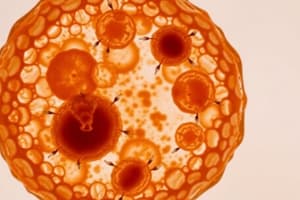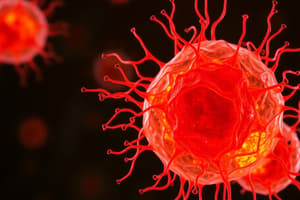Podcast
Questions and Answers
What is the primary function of mitotic cells in the body?
What is the primary function of mitotic cells in the body?
- To facilitate cell death
- To undertake specialized functions
- To provide structural support
- To replenish and regenerate tissues (correct)
Which of the following cells are examples of post-mitotic cells?
Which of the following cells are examples of post-mitotic cells?
- Neurons and heart muscle cells (correct)
- Epithelial cells and fibroblast cells
- Stem cells and endothelial cells
- Fibroblast cells and heart muscle cells
What is the primary difference between mitotic cells and post-mitotic cells?
What is the primary difference between mitotic cells and post-mitotic cells?
- Their function in the nervous system
- Their location in the body
- Their structure and composition
- Their ability to undergo mitosis (correct)
How do post-mitotic tissues regenerate?
How do post-mitotic tissues regenerate?
What is true about the regeneration of post-mitotic tissues?
What is true about the regeneration of post-mitotic tissues?
Which of the following is an example of a mitotic cell?
Which of the following is an example of a mitotic cell?
What is the term used to describe cells that are capable of dividing by mitosis?
What is the term used to describe cells that are capable of dividing by mitosis?
What is a key limitation of post-mitotic cells?
What is a key limitation of post-mitotic cells?
What is the main purpose of DNA replication in mitosis?
What is the main purpose of DNA replication in mitosis?
What is the shape of DNA in eukaryotes like humans?
What is the shape of DNA in eukaryotes like humans?
What is the function of telomeres?
What is the function of telomeres?
What happens to telomeres each time DNA is copied?
What happens to telomeres each time DNA is copied?
What is the approximate number of cell divisions a cell can undergo before reaching senescence?
What is the approximate number of cell divisions a cell can undergo before reaching senescence?
What is the term for the number of times a cell can divide before reaching senescence?
What is the term for the number of times a cell can divide before reaching senescence?
What is the state of a cell that has reached senescence?
What is the state of a cell that has reached senescence?
What happens to a senescent cell?
What happens to a senescent cell?
What is the term for the type of senescence caused by telomere shortening?
What is the term for the type of senescence caused by telomere shortening?
What is the role of senescent cells in the body?
What is the role of senescent cells in the body?
What is the function of Telomerase during cell replication?
What is the function of Telomerase during cell replication?
What happens to somatic cells when they develop a mutation that causes them to express Telomerase?
What happens to somatic cells when they develop a mutation that causes them to express Telomerase?
What is the significance of Telomerase in stem cells?
What is the significance of Telomerase in stem cells?
What is the Hayflick limit?
What is the Hayflick limit?
What is a potential consequence of somatic cells expressing Telomerase?
What is a potential consequence of somatic cells expressing Telomerase?
What is the effect of Telomerase on telomere length during cell replication?
What is the effect of Telomerase on telomere length during cell replication?
What is the primary reason why cells transform into a senescent state?
What is the primary reason why cells transform into a senescent state?
What is the outcome when a cell reaches its Hayflick limit?
What is the outcome when a cell reaches its Hayflick limit?
What can cause a cell to become senescent?
What can cause a cell to become senescent?
What is a potential consequence of having senescent cells in tissues?
What is a potential consequence of having senescent cells in tissues?
Which cells are capable of undergoing replicative senescence?
Which cells are capable of undergoing replicative senescence?
What is the main difference between somatic cells and stem cells in terms of cell division capacity?
What is the main difference between somatic cells and stem cells in terms of cell division capacity?
What enzyme is responsible for maintaining telomere length in stem cells?
What enzyme is responsible for maintaining telomere length in stem cells?
What is the relationship between the number of doublings and cell division capacity in somatic cells?
What is the relationship between the number of doublings and cell division capacity in somatic cells?
What is a benefit of cellular senescence?
What is a benefit of cellular senescence?
What is the current understanding of senescent cells in relation to age-related diseases?
What is the current understanding of senescent cells in relation to age-related diseases?
Flashcards are hidden until you start studying
Study Notes
Cell Division and Senescence
- Cells in the body can be divided into two types: mitotic cells and post-mitotic cells
- Mitotic cells can divide by mitosis to replenish and regenerate tissues, including epithelial cells, fibroblast cells, and endothelial cells
- Post-mitotic cells, such as neurons and heart muscle cells, are incapable of proliferation and have a limited ability to repair or regenerate tissues
Telomeres and DNA Replication
- Telomeres are caps at the ends of linear DNA strands that prevent damage during DNA replication
- DNA replication machinery does not copy DNA all the way to the end, resulting in telomere shortening with each replication cycle
- Telomeres shorten with each cell division, and when they become too short, the cell reaches replicative senescence
Replicative Senescence
- Replicative senescence is a state where a cell can no longer divide due to telomere shortening
- The number of times a cell can divide before reaching senescence is called the Hayflick limit (around 60-70 divisions)
- Senescent cells undergo changes, such as gene expression, appearance, and cellular response, and are no longer allowed to replicate to prevent DNA damage and potential cancer
Causes of Senescence
- Telomere shortening due to DNA replication
- DNA damage from mutations or toxins
- Abnormal telomere function
- Other causes that threaten DNA integrity
Problems with Senescent Cells
- Senescent cells can help prevent tumors by stopping division, but as tissues accumulate more senescent cells, the tissue's ability to repair itself is impaired
- Evidence links senescent cells to age-related diseases, such as cataracts
Types of Cells and Division Capacity
- Mitotic cells have a high cell division capacity, but it decreases with the number of doublings
- Stem cells have a high cell division capacity that remains constant due to telomerase, an enzyme that maintains telomere length
- Somatic cells can develop a mutation causing them to express telomerase, allowing them to escape senescence and potentially lead to cancer
Studying That Suits You
Use AI to generate personalized quizzes and flashcards to suit your learning preferences.



